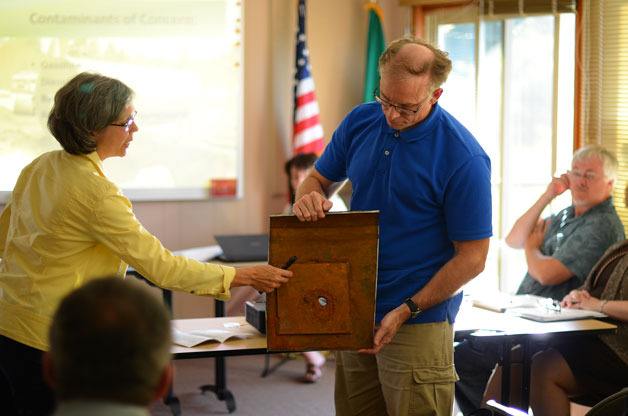New monitoring wells that would track the underground progress of an old fuel spill in Freeland’s sea-level aquifer may be in place by September, state regulators said Monday.
At a meeting with the Freeland Water and Sewer District, state Department of Ecology officials went over a plan to install four such wells within 400 feet of the spill site.
At a cost of about $20,000 each, the wells would help monitor the plume through the aquifer, which is about 100 feet below the surface.
“We could potentially be out there in a month drilling these wells,” said Eugene Freeman, site manager with the agency’s Voluntary Cleanup Program.
In 2005, the owner of Whidbey Marine and Auto Supply on Main Street reported a release of thousands of gallons of fuel from one the store’s fuel tanks.
The station closed in 2008 but the owner is participating in the state cleanup program and was able to recover about 2,000 gallons. What could not be collected was continually watched with several wells drilled nearby.
That monitoring, however, has revealed the fuel has reached Freeland’s sea-level aquifer. It’s the source of the area’s water supply and the direction of the plume appears to be heading toward the water district’s wells.
They provide water to about 90 commercial business and nearly 400 residences.
District commissioners were alerted to the issue within the last two months. Nearly immediate testing and negative results for contamination at the wells has helped settle some nerves but it was clear Monday that board members wanted more than a history lesson; they wanted answers.
“The nitty-gritty here, of course, is what this means for us,” said Eric Hansen, president of the district’s board of commissioners. “That’s the key question for us that remains. Is our water supply in imminent danger?”
The consensus among experts at the meeting was not now and probably never. Department officials characterized the danger last week as “moderate,” but Island County Hydrologist Doug Kelly said underground spills have a limited reach and lifetime.
Small spills don’t usually travel more than a few hundred feet, medium leaks more than 500 feet and large spills more than 1,000 feet.
The district’s wells are about 1,900 feet away, Kelly said.
Also, data on other spills show that plumes don’t continue to expand after the source has stopped. In this case, the spill was arrested about eight years ago.
“I’d be very surprised if this plume is still growing,” Kelly said.
Freeman agreed with the assessment, but both also said additional monitoring wells should be installed just to be sure.
It’s still not clear how far the plume has spread and they will provide a better picture about concentrations and distance traveled.
Freeman said the new wells will be placed in locations believed to be ahead of the fuel plume. Immediate contamination results may dictate the need for additional wells, he said.
“Basically, with each step we’re trying to figure out where the head of the plume is,” Freeman said.
He stressed that ecology’s role in the wells is largely advisory. The bill and the work is the responsibility of the former station’s owner.
Also unclear is the quantity of fuel spilled. Louise Bardy, Voluntary Cleanup Program supervisor, confirmed last week a leakage of 7,000 gallons, but revised that to just 3,000 gallons at Monday’s meeting.
Several people questioned her on the discrepancy and she said the latter number is the only figure she could find in ecology documents before the meeting.
An attachment to a June 3 letter from ecology regulators to the station owner’s hired consulting firm shows the release as 7,000 gallons.
In an interview following the meeting, Bardy said she could not be certain of the true number but, according to Freeman, a 5,000-gallon difference is inconsequential.
It may seem like a lot, but underground fuel-tank leaks are common and some are much larger by comparison. He cited one case that resulted in a spill in excess of 16,000 gallons.
Freeman noted that while drilling wells could begin within one month, the timeline will depend on agreements with private property owners.
Commissioner Eric Hansen said the district may not wait solely on ecology for news and may “do some investigation ourselves.”
That will likely include watching for contaminants in district wells, though just how often will depend on the data revealed by the new wells.
“Routine testing at our wells will be important,” Hansen said.



